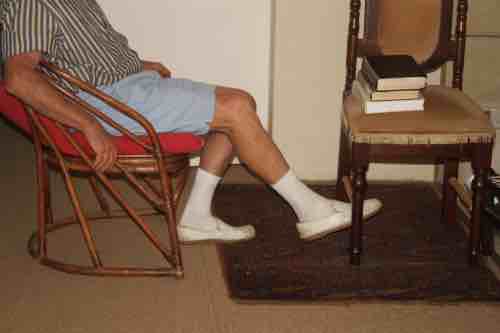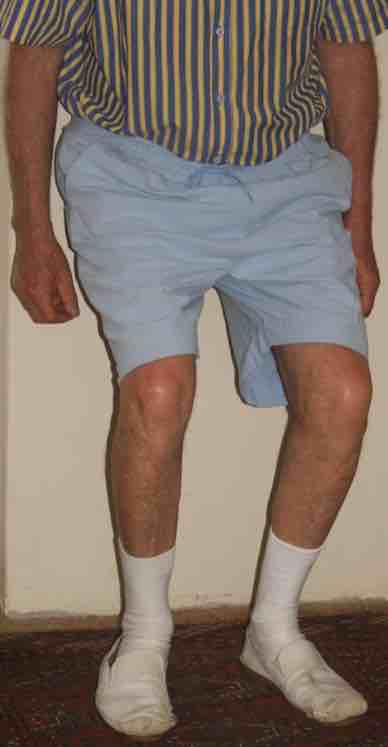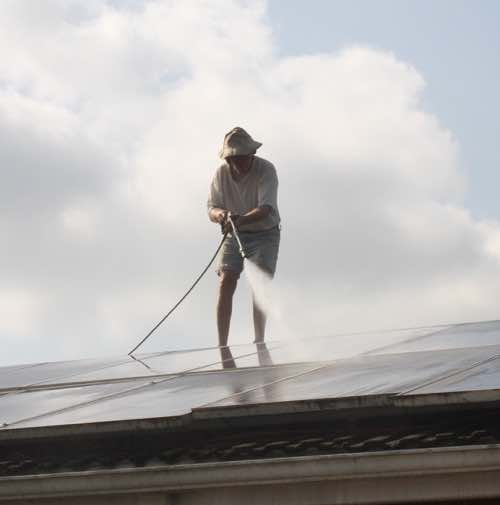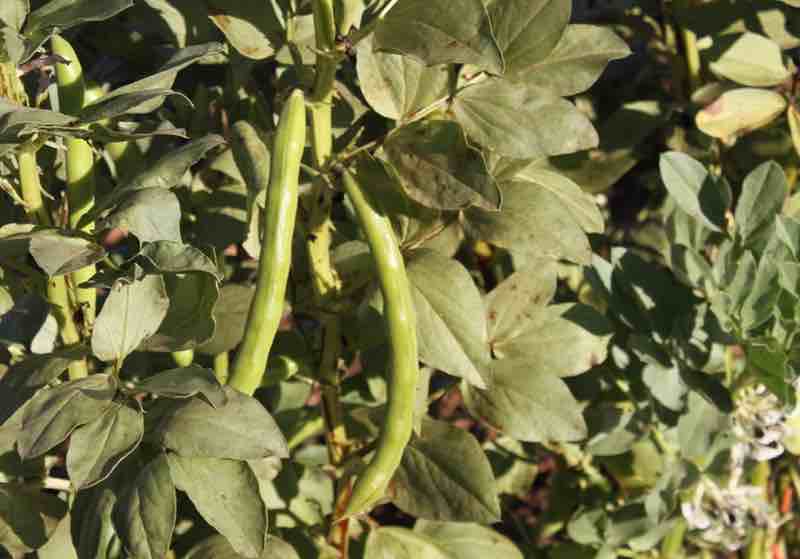- Bernard Preston homepage
- Frailty syndrome
- Leg Strength and Longevity
Leg strength and longevity
This page on leg strength and longevity looks at balance, walking speed and the quadriceps muscles.
The longevity of those living such healthy, vigorous lives in their dotage in the five Blue Zone places in the world is a complex affair. If it was simple we would all dwell victoriously to be a hundred plus; but we don't, so many falling far short of the allotted mark.
Researchers have likened longevity to a four-legged stool.
- Better food
- Physical activity
- Mental engagement
- Social connectedness
In this short essay we look at physical activity.
Balance and longevity
Balance is coordinated by three independent systems in the body.
- The eyes focus on the horizon, attempting to keep it level.
- A healthy neurological system brings sensory information from the feet to the brain giving information about one's position in space.
- Tiny organs in the inner ears help to coordinate movement.
All three need to be exercised; and the easiest way is simply to spend additional time outside in the sunshine; it improves eyesight and obviously one is more active. Leg strength is not enough; balance is equally important.
After standing up from a chair, a very simple exercise is to rotate the whole body through 360o, first in one direction and then the opposite.
Secondly stand at the kitchen counter with a finger lightly on the surface. Raise one foot off the ground, now raise your hand and practise balancing on your leg.
Gait speed and longevity
Draw two chalk lines 10m apart. Practise walking and timing yourself; can you cover the distance in under 12.0 seconds? Then you can be pleased.
Researchers found that 80 year olds who could walk the 10m in 11.4 seconds on average lived to 95; more than another decade.
It is highly recommended that for as long as possible we walk briskly for 20 minutes daily; when you can no longer manage that, try for 15 and then 10. Make half a dozen 10m spurts of speed if possible.
Sloth that word made famous by John Bunyan keeps us comfortably seated on the couch or at the computer. It's all about leg strength and longevity; does not an extra 15 good years sound like music in your ears?
30 second chair stand test
The chair stand test is in particular a measure of the strength of the quadriceps muscles in the thigh; but in fact of the whole leg.
Settle comfortably in a chair about 43cm high; cross your arms across your chest. Ask a friend to time out 30 seconds. How many complete sit to stand moves can you make[2]?
The average 80-year old should be able to do about 12 stands. 15 and above is excellent; less than 9 is of concern.
There are many recommended ways of developing the quadriceps muscles; leg strength and longevity.

- This isometric contraction is in fact the best. Sit on a stool with your foot hooked under the rail of another chair. Contract the muscles of the thigh to about 80% of your strength, hold for 45 seconds and then relax.
- The second is to stand with your heels about 6" from a wall, bend the knees just a little and slide the buttock downwards. Don't go too deep. Hold for 45 seconds.

Done several times daily these two exercises will significantly drop your blood pressure too; by enough to get many people off hypertensive medication.
SUMMARY
These balance exercises, half a dozen gait speed challenges and quadriceps training for leg strength could all be done in ten minutes every day. In comparison with those who do none of them, scientists have shown there is every chance you will live to enjoy an extra 15 good years; that's massive.
Leg strength and longevity
Leg strength and longevity are closely correlated. Strong thigh muscles are also associated with increased bone mineral density in the hips; fewer falls and fractures in the elderly enable them to continue for more precious years doing the things they are passionate about.

Elderly Cyan Zone people need strong legs and good balance; cleaning of solar panels must be done periodically.
The other three legs of the chair
Better food, social connectedness and mental engagement are the other three legs of the chair that the Blue Zone researchers talk about.
- Try and eat at least 7 different coloured foods every day; for their phytonutients that protect us from serious disease.
- Staying regularly in contact with family, friends and other groups of people is core to a happy, fulfilled life.
- Play games like chess, do Sudokus and crosswords; and consider joining a book club or bible study group, for example.
May you live to be a hundred!
A gardening club and longevity
A gardening club would help one attain all four of these objects. You meet with other like-minded people, get plenty of leg strength exercise and share with fellow greenies how they successfully grow fresh, organic fruit and vegetables.
"There is increasing evidence that exposure to plants and green space and particularly to gardening, is beneficial to mental and physical health."
- Clinical Medicine (PMC6334070)[2]
The mental challenge in these last weeks how been how to rid our broad beans from the dreaded black fly without using an insecticide. The soapy water from the laundry, dribbled over the vulnerable tender leaf tips and flowers has done the trick.

The broad bean is the only plant that will supply pharmaceutical amounts of dopamine, the happy hormone; good news for Parkinson's Disease patients especially. It is no coincidence that in all five of the Blue Zone countries they independently grow and enjoy these legumes.

Sardinia
In the mountainous part of Sardinia, a cluster of villages makes up one of the five Blue Zone areas of the world; living to a zestful, busy ninety is the norm.
What distinguishes these long-living people from the rest of the island is not the food they eat, their customs or genes. It's the fact that they walk up and down stairs daily and to get anywhere they have to exercise their quadriceps muscles; it is hilly. Leg strength and longevity are closely intertwined.
How do I improve my longevity?
We are looking here at not only length of life but also quality years. It's the small stuff done regularly that really makes the difference. Taking a walk in the sunshine, enjoying many coloured foods and avoiding processed nosh all rank on the things that we can do.
"Life span" has little meaning if the last ten years are spent in bed, disabled or having lost our marbles.
In fact walking after every starchy meal and especially supper the researchers tell us is particularly important.
When browsing use right click and "Open Link in New Tab" or you may get a bad gateway signal.
Newsletter
Our newsletter is entitled "create a cyan zone" at your home, preserving both yourself and Mother Earth for future generations; and the family too, of course. We promise not to spam you with daily emails promoting various products. You may get an occasional nudge to buy one of my books.
Here are the back issues.
- Lifestyle and ideal body weight
- What are ultra-processed foods?
- Investing in long-term health
- Diseases from plastic exposure
- Intensive lifestyle management for obesity has limited value
- A world largely devoid of Parkinson's Disease
- The impact of friendly bacteria in the tum on the prevention of cancer
- There's a hole in the bucket
- Everyone is talking about weight loss drugs
- Pull the sweet tooth
- If you suffer from heartburn plant a susu
- Refined maize meal and stunting
- Should agriculture and industry get priority for water and electricity?
- Nature is calling
- Mill your own flour
- Bake your own sourdough bread
- Microplastics from our water
- Alternative types of water storage
- Wear your clothes out
- Comfort foods
- Create a bee-friendly environment
- Go to bed slightly hungry
- Keep bees
- Blue zone folk are religious
- Reduce plastic waste
- Family is important
- What can go in compost?
- Grow broad beans for longevity
- Harvest and store sunshine
- Blue zone exercise
- Harvest and store your rainwater
- Create a cyan zone at your home
Did you find this page interesting? How about forwarding it to a friendly book or food junkie? Better still, a social media tick would help.
- Bernard Preston homepage
- Frailty syndrome
- Leg Strength and Longevity
Address:
56 Groenekloof Rd,
Hilton, KZN
South Africa
Website:
https://www.bernard-preston.com